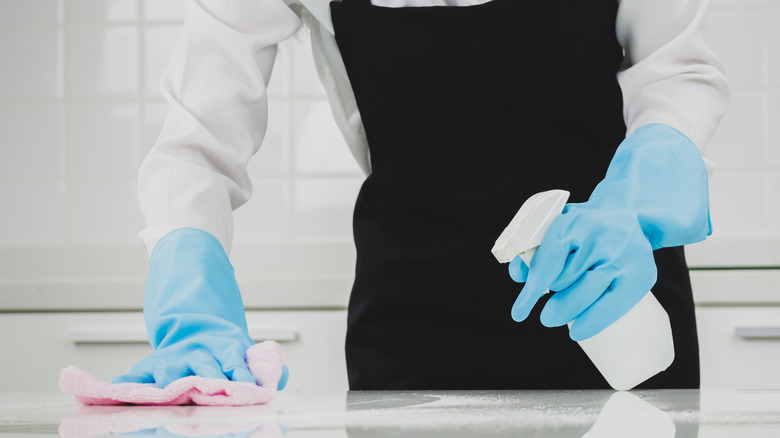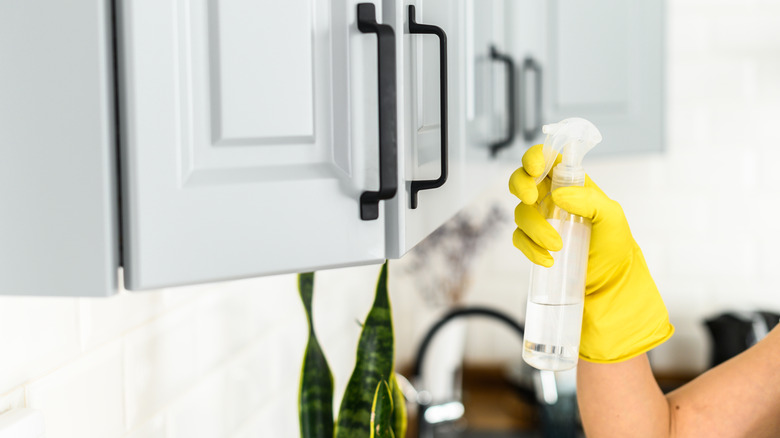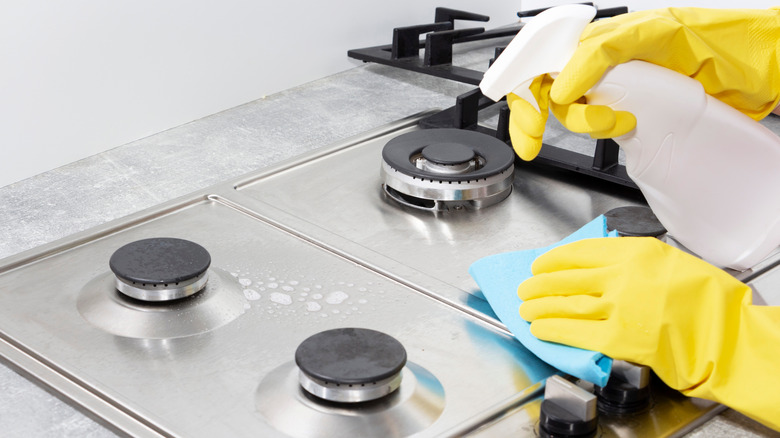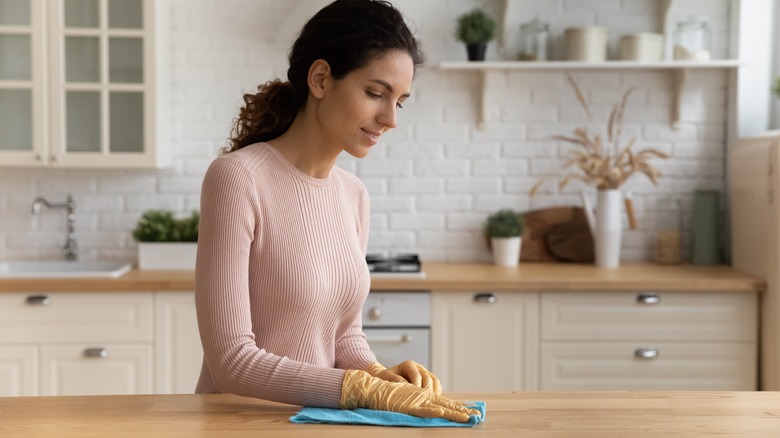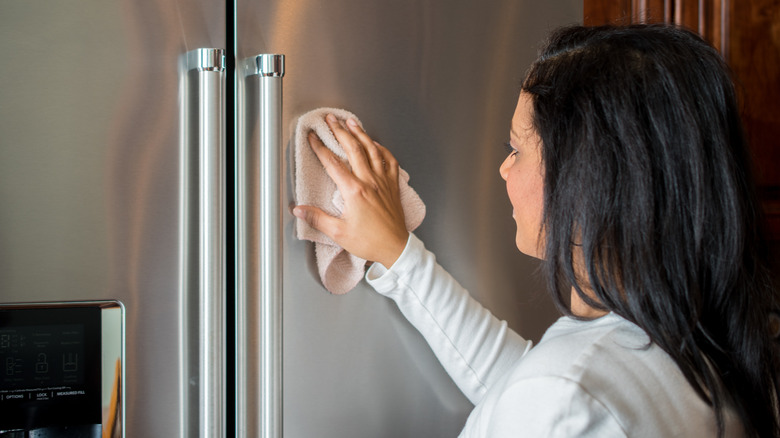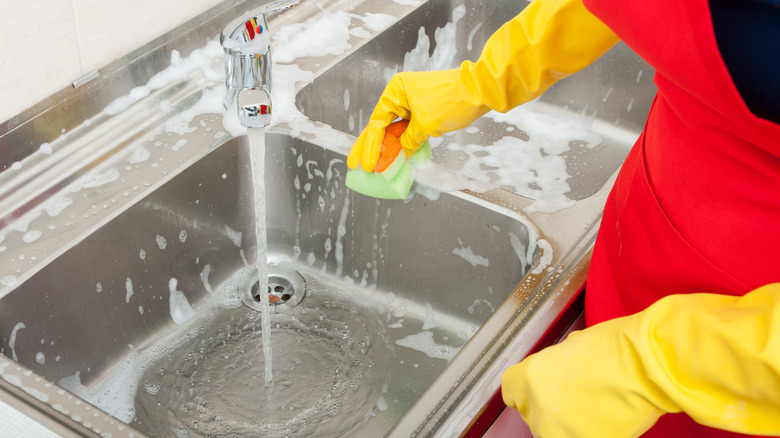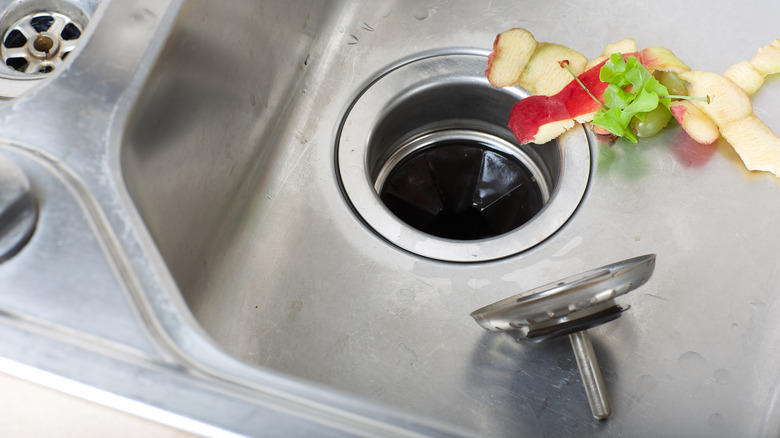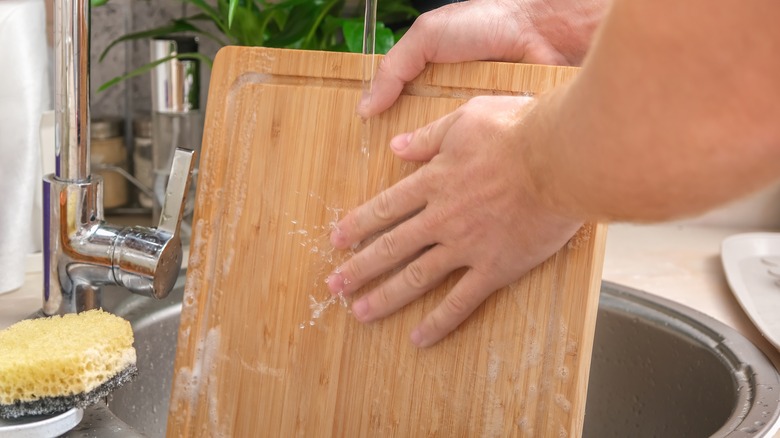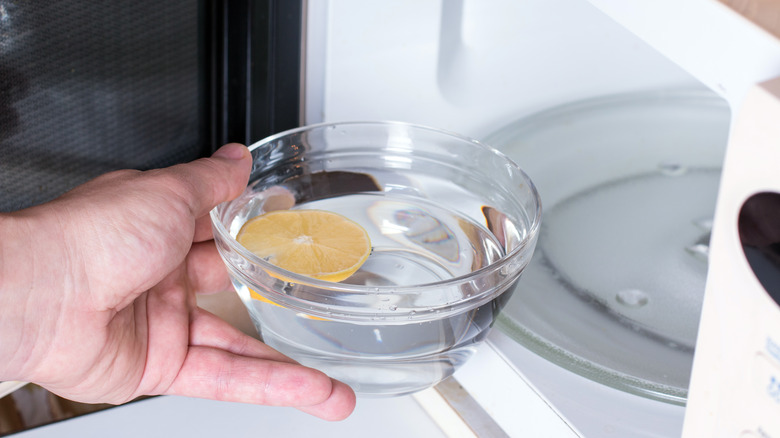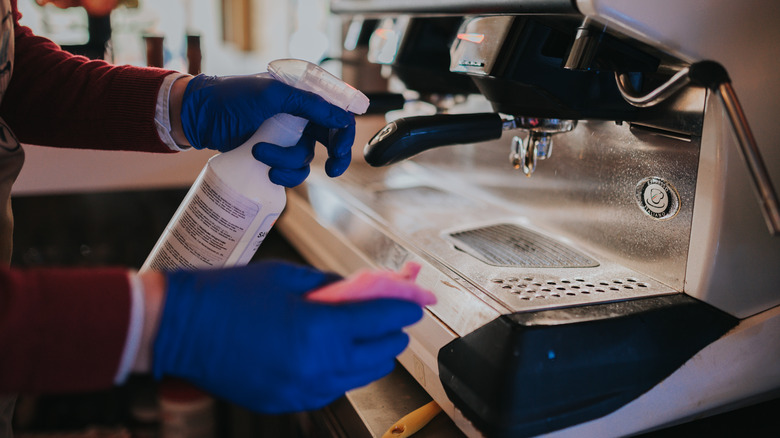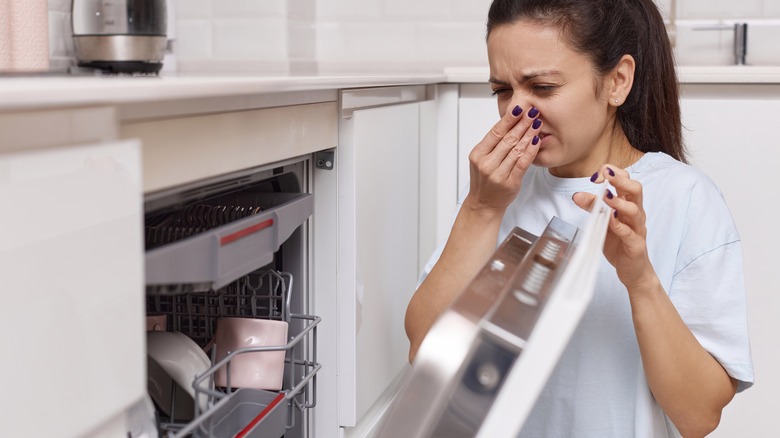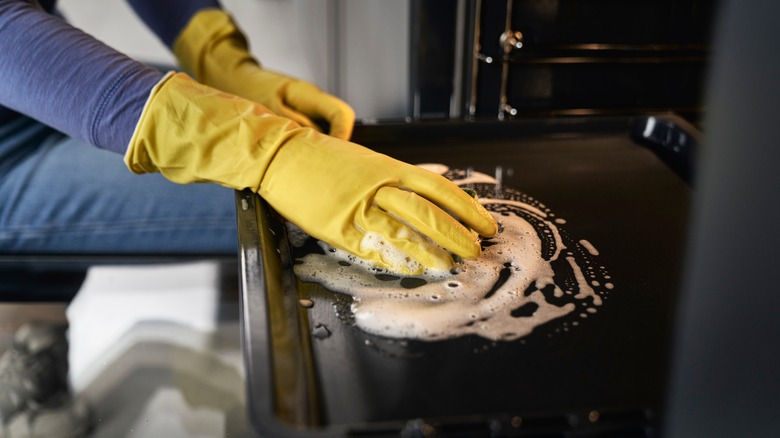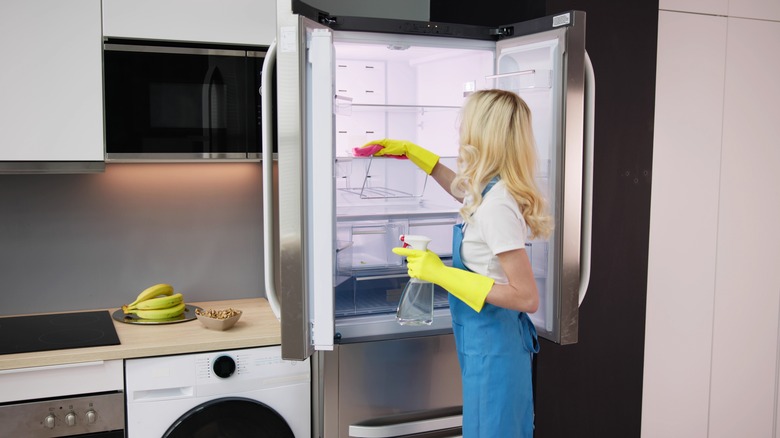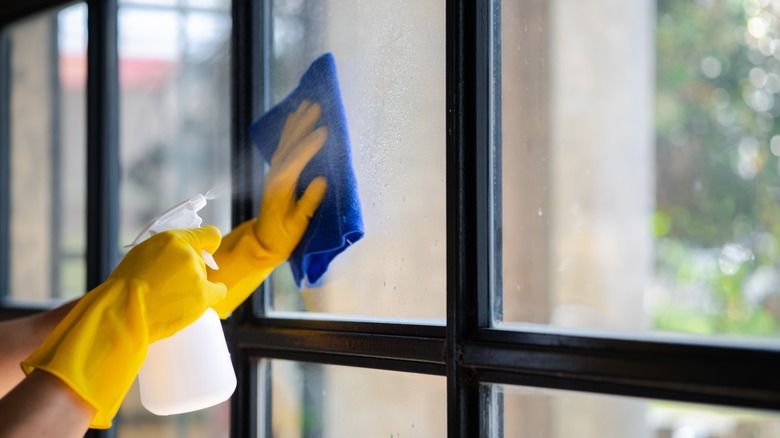All The Different Ways You Can Use Vinegar To Make Your Kitchen Sparkle
Vinegar is a popular pantry staple, and it's a great ingredient to use in everything from cooking to cleaning. While you may be familiar with the basic concept of vinegar as a natural cleaner, the many ways you can safely use it throughout your kitchen are usually underestimated. Vinegar can make your kitchen sparkle, and it's not just about simply wiping down the countertops or cleaning the windows; it's also about lesser-known and innovative vinegar applications that can transform your kitchen cleaning routine. From deodorizing your garbage disposal to restoring the shine on cabinet hardware and tackling the grease on your stove hood with a homemade vinegar paste, this ingredient does it all.
Understanding the correct methods, mixtures, and precautions takes vinegar from a cooking ingredient and transforms it into a powerhouse cleaning agent. However, there are also critical nuances to remember when you use it, including where it shines, falls short, and what alternatives you can try to ensure your kitchen is as clean as possible. The goal isn't to rehash the same tired cleaning hacks; instead, you'll unlock vinegar's full potential as a cleaning agent, making you embrace its effectiveness and role as an eco-friendly alternative.
A vinegar soak restores cabinet hardware
If you have drawer pulls in the kitchen that look grimy or tarnished, it's possible to clean them with vinegar and water. Get a large bowl to hold your hardware, detach the hardware from the cabinets, and add enough vinegar and water, mixed at a 1:1 ratio, to cover them. Set this bowl out of the way and let them soak for a few hours or even overnight. The vinegar will break up the grime and gently dissolve the tarnish, making it an excellent way to restore the hardware's original shine. When you're ready to take them out, gently buff the hardware with a soft cloth before putting it back on your cabinets.
The vinegar's acidity is strong enough to break down the tarnish or oxidation that builds on metal over time. However, Rotax Metals points out that if you try this with bronze, brass, or plated items, the acid can cause them to corrode or get damaged, even if you only soak them for a few hours. If you have this type of hardware and want to clean it, try a specialized metal cleaner specifically designed for the type of metal your hardware is made of. This will give you a safe, but effective, clean without the risk of damage.
Remove new or light grease stains with vinegar
If you have light or new grease stains in your kitchen, like on the backsplash, stove hood, floors, or walls, diluting vinegar and water is very effective for cleaning. Get a spray bottle, mix 1 cup of vinegar with 1 cup of water, and shake it to incorporate them. Spray the mixture right onto any grease stains, allowing it to sit for a few minutes to get through the grease. Get a brush and scrub in a circular motion for tougher areas to loosen them up. Wipe the area clean using a damp, soft cloth.
This method works because once you apply the vinegar, the acetic acid breaks the grease bonds and makes them easier to wipe away. It works well for fresh grease stains by cutting through the slick layers and cleaning your surfaces. However, while it works for recent grease stains, it won't be as effective if you try to use it for caked-on, old grease. This is because older grease has likely been exposed to heat or temperature fluctuations, leading to oxidation and polymerization. Additionally, the grease molecules may have had time to form larger, more complex structures. In turn, it doesn't react to the acetic acid well. To tackle old grease stains, use a few drops of dish soap and water to wipe them down.
Spray vinegar to clean countertops
Creating a solution with vinegar and water is a very effective tool to keep your kitchen sanitary and clean. To clean your counters, get a spray bottle and add a 1:1 mixture of vinegar and water. Spray the mixture onto your countertops and allow it to sit for a few minutes to break down any built-up grime, dirt, and bacteria. You can safely spray it on tile, laminate, and stainless steel surfaces. Get a clean sponge or cloth, dampen it under lukewarm water, and wipe away any loose debris and vinegar residue to get clean and sanitized countertops.
The acetic acid content in vinegar is the key to its effectiveness as a cleaning agent. This makes vinegar a natural disinfectant, and in a 2014 study by the American Society of Microbiology, they found that vinegar is potent enough to kill the microorganisms that carry and spread tuberculosis. The acid breaks down and dissolves contaminants on contact, and it works by changing the pH levels on the countertops, making it an unlivable surface for many germs and bacteria.
However, while vinegar is an excellent choice on many counters, don't use it on stone surfaces like granite and marble. Doing so can lead to etching and damage to how the counters look. Instead, create a milder cleaning solution of water with a few drops of dish soap, and use rubbing alcohol and water to sanitize.
Vinegar makes stainless steel appliances shine
When it comes to keeping your stainless steel appliances looking pristine, a highly-effective method involves using vinegar. Get a soft cloth and a bottle of white vinegar, and slowly pour a mixture of vinegar and water onto the cloth until it's damp. Don't soak the fabric until it's dripping; you'll have a mess on the floor and excessive liquid on your stainless steel appliances. Carefully wipe down your appliance surfaces, starting at the top and working your way down. Wipe in the direction of the metal's grain as you work, so it doesn't dull the luster. Get a dry cloth, gently wipe away the excess, and allow the appliances to air dry.
The mild acidity vinegar offers is the key to how effective it is for cleaning stainless steel. The natural acid is wonderful for breaking down and dissolving the residues and oils that create fingerprints. Using vinegar on a soft cloth removes these blemishes to leave a polished, immaculate finish. While you can use undiluted vinegar, frequently doing so can cause pitting on the surface of the stainless steel. Pitting is localized, small spots that detract from your appliances' look. To safeguard against this, dilute the vinegar in a 1:1 ratio with water before you use it, or swap it out for a mixture of dish soap and water.
Use a vinegar paste to refresh the sink
To refresh your sink and get a sparkling clean, use vinegar and baking soda. Get your sink area damp and sprinkle a generous layer of baking soda onto it. Apply the vinegar directly to the baking soda to create a fizzing action. It only lasts a few seconds, but it'll loosen up stains and make a slightly-abrasive cleaner that helps scrub food particles and grime away. Get a brush or soft sponge and gently work the paste in a circular motion across your sink, paying close attention to disclosed or stained areas. This method works well for removing water spots, tough stains, and neutralizing odors to keep your sink super fresh, all while using eco-friendly products.
You get a powerful cleaner when you pair vinegar's acidity with baking soda's abrasiveness. Baking soda helps scrub tough stains and buildup without scratching your sink, and the acid in vinegar dissolves mineral deposits. However, be careful when you apply this mixture to certain metal sink types, because the Connecticut Science Center says vinegar's acid content speeds up oxidation, potentially leading to rust, especially with cast iron or aluminum. As an alternative cleaner, mix a few drops of dish soap with water to clean the sink, or make a baking soda paste with baking soda and water to remove the acid content all together.
Use vinegar to deodorize the garbage disposal
To clean and deodorize your garbage disposal, pour a cup of white vinegar into it. The acidic nature of vinegar will neutralize odors by breaking down any food particles and grime. Allow the vinegar to sit for five to 10 minutes before flushing it with hot water. This will help address any immediate odors you have, and it helps clean the blades to enhance how well the disposal works.
However, you should note that while vinegar is very effective for the occasional cleaning and deodorizing project, it can disrupt the natural balance of good bacteria. These bacteria are essential to breaking down any waste that goes through the disposal, and overusing vinegar could negatively impact how well leftover waste breaks down. Instead, use a combination of lemon, white vinegar, and baking soda for routine maintenance to get a slightly abrasive cleaner. Mr. Rooter Plumbing suggests grinding citrus peels by themselves to fight odors, and their natural oils clean the blades, while leaving good bacteria intact.
Spray vinegar to disinfect cutting boards
One effective way to clean and disinfect your cutting boards, especially when cutting vegetables or meat, is to spray them with undiluted white vinegar. Fill a spray bottle with white vinegar and add a generous coating to the cutting board's surface. Leave the vinegar on your cutting boards for a few minutes to give the disinfecting properties time to work. After a few minutes, rinse your cutting board with water, pat it dry with a clean cloth, or allow it to air dry.
Vinegar is a popular disinfectant for cutting boards because its acidity kills various germs and bacteria that you commonly find lurking around the kitchen. The acetic acid content penetrates the bacteria's cell walls and destroys them. This is particularly useful for wooden cutting boards, because they can absorb bacteria and aren't suitable to pop into the dishwasher. However, vinegar won't kill every germ or bacteria, and the Harvard T.H. Chan School of Public Health points out that it's not strong enough to eliminate pathogens like E. coli and salmonella. For a more potent disinfectant, dilute a tablespoon of bleach into a gallon of water and spray it on the cutting board. Allow it to sit for 10 to 15 minutes and rinse it thoroughly to remove any lingering bleach residues before using it.
Heat a bowl of vinegar to clean the microwave
One of the easiest ways to clean the microwave with vinegar is to mix equal parts water and vinegar in a microwave-safe bowl. Put this bowl into your microwave and heat it on high power for several minutes, until it starts to boil and steam. Turn off the microwave and let the mixture sit with the door closed for 10 to 15 minutes to help loosen any grime or food splatters. Once the bowl cools enough that you can safely handle it, remove it. Take a sponge or cloth, dip it into the warm vinegar and water solution left in the bowl, and wipe down the inside of the microwave.
This method works due to vinegar's natural properties and steam cleaning mechanics. Since its acidic, vinegar breaks down substance bonds, like food particles and grease, making them easier to scrub off. When heated, the vinegar and water steam and fill the microwave to soften up grime and stains on the inside of the microwave. The steam cleaning effect makes cleanup hassle-free, with minimal effort. Vinegar is also non-toxic and eco-friendly, but it can release a strong odor when you heat it. In enclosed kitchens without good ventilation, research from 2016 from Encyclopedia of Food Sciences and Nutrition points out that the vapors can irritate your nose, eyes, and throat. To mitigate this, ensure good ventilation, or add citrus fruit slices to water and steam it, skipping the vinegar.
Descale the coffee maker with vinegar
A mixture of equal parts water and white vinegar is an effective and natural method to remove mineral buildup and descale your coffee maker. Start by filling your coffee maker's reservoir with a 1:1 ratio of white vinegar and water and run the brew cycle to let the mix work through your machine. As it does, it'll descale it by stripping away any lime, calcium, and other mineral deposits that build up over time. Once the cycle is finished, dump out the vinegar solution and run two cycles of plain water to rinse any vinegar residue still inside the coffee maker.
Vinegar's acidity is why it's so effective for this common cleaning task. White vinegar's acidity is strong enough to tackle grease, dissolve mineral deposits, and remove scale buildup without harming your coffee maker's internal components. The mineral deposits will affect how well your machine performs, as well as the coffee's taste. You should note that even though vinegar acts like a wonderful natural descaler, its acidic nature will eventually degrade plastic or rubber components. So, while Molly Maid suggests cleaning your coffee maker once a month, limit this deep-cleaning method to only a few times a year, depending on how often you use your coffee maker and how hard your water is.
Eliminate dishwasher odors with vinegar
Vinegar works to eliminate residue buildup and odors in your dishwasher for an eco-friendly and straightforward approach. Get a dishwasher-safe cup and fill it with white vinegar, then put it on the top rack of your empty dishwasher. Close the dishwasher and run a full cycle at the hottest temperature. This process will disperse the vinegar throughout the dishwasher as the cycle runs, helping strip away grease, odors, and soap residue that builds up in the hidden areas inside. Vinegar will break down the residue, leaving the dishwasher significantly cleaner and smelling fresh.
Vinegar cuts through grease and grime without harsh chemicals to ensure a very thorough clean. However, you must be mindful that, even though vinegar is effective as a cleaning agent, the acidity can negatively impact the rubber components inside the dishwasher. Frequently using vinegar can cause deterioration of these components, leading to leaks. So, while you can use it to clean, use it sparingly. Limit this method to once per month to help control odors and keep your dishwasher in top condition, while safeguarding the rubber components.
Clean grime from the oven with a vinegar steam
Start by preheating your oven to a lower temperature, around 250 degrees Fahrenheit. Mix equal parts water and vinegar in a baking dish or oven-safe bowl and put it into the oven. Shut the door and let it heat until you see steam forming, usually 15 to 20 minutes. This will loosen and soften any grime, stains, and food splatters you see baked onto the oven. Switch the oven off and allow it to cool before wiping away the loose debris using a sponge or damp cloth. The vinegar solution's steam gets into the gunk, and the acidity of the vinegar helps break it down.
The vinegar and steam combination removes baked-on food residue and other stains without harsh chemicals, making it safer to use. However, you should note that if your oven has significant grease buildup, the grease can neutralize vinegar's acidic effects, making it less effective for dissolving grease. If your oven has a lot of grease buildup, an alternative would be to make a paste using baking soda and water, apply it liberally in greasy spots, and allow it to stay on for several hours or overnight. The baking soda is mildly abrasive and alkaline, which breaks down grease better than vinegar. Wipe the oven with a damp cloth to remove the paste, grime, and grease to get a deep clean.
Deodorize and clean the refrigerator with vinegar
Mix equal parts white vinegar with water to deodorize and clean the refrigerator. Add this mixture to a spray bottle or bowl and wipe down the refrigerator's interior surfaces, including any drawers, shelves, and walls, focusing on the door seals. The door seals can be a collection point for mold and mildew due to trapped moisture, so paying attention to these spots. Vinegar helps remove spills and eliminate unpleasant odors, leaving your refrigerator clean and fresh.
The acidity of vinegar makes it a great help when deep cleaning your fridge, cutting through grim, dirt, and sticky residue without harsh chemicals. It's a natural disinfectant and can get rid of some bacteria, germs, and viruses to help keep this appliance in a safe spot to store your food. But vinegar's potent smell can linger in your refrigerator after you use it to clean, and it can add a taste to sensitive foods. To stop this, rinse every surface you clean with water and, if needed, leave the refrigerator open for a bit to air out. If you're sensitive to the smell of vinegar, create a mixture of water and baking soda to clean. Baking soda absorbs odors without leaving a scent, making it a suitable substitute for vinegar in keeping your refrigerator clean and odor-free.
Spray vinegar to get streak-free glass
Vinegar is the secret to get clean, streak-free windows and mirrors in your kitchen. To use it, make a cleaning solution by mixing a 1:1 ratio of vinegar and water in a spray bottle. Spray this mixture directly on the glass surface you want to clean. Once you cover the area, wipe it away with a clean, lint-free cloth using a circular motion. For the best results, work from the top to the bottom and cover every inch of glass. This method works well for regular maintenance cleaning to keep your mirrors and windows bright and clean without restoring to chemical-based cleaning agents.
When you apply vinegar, it'll start dissolving the fingerprints, dirt, and grime that build up on the glass over time. Also, unlike a lot of the commercial glass cleaners you can use, there is no residue — and residue is usually what causes streaking. Instead, when the vinegar dries, it completely evaporates. However, if you have exceptionally dirty windows or they have a greasy film, you may need to repeat the cleaning process a few times to remove the buildup and get a streak-free shine. You can pre-clean the windows with dish soap and water, too, and this will strip away a lot of the grime before the vinegar comes in and lifts the rest.
